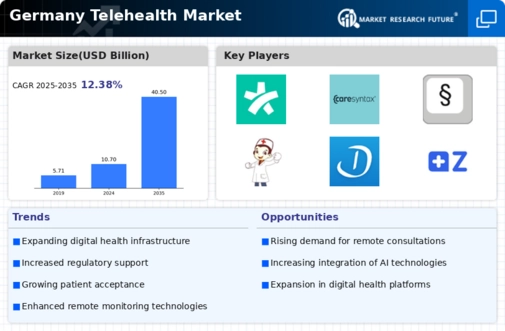The competitive landscape of the German telehealth Market is dynamic and increasingly complex, driven by technological advancements and shifts in healthcare delivery models. Telehealth has gained prominent traction mainly due to the increased demand for remote healthcare services exacerbated by the COVID-19 pandemic. This has spurred both established healthcare organizations and new entrants to innovate and provide solutions that meet the changing needs of patients and providers alike. In this environment, companies are focusing on enhancing user experience improving access to healthcare, while ensuring compliance with regulations, which presents both opportunities and challenges for market participants.
Key players are adopting diverse strategies, including partnerships and technological integrations, to elevate their positions in this ever-evolving sector.Jameda has established itself as a leading platform in the Germany Telehealth Market by focusing on connecting patients with healthcare providers through its user-friendly online portal.
One of the primary strengths of Jameda lies in its extensive database of healthcare professionals, which is enriched by patient reviews and ratings, enabling users to make informed decisions about their healthcare choices. The platform's robust search functionalities and appointment booking systems have significantly enhanced patient engagement and convenience, leading to increased usage. Jameda's strong market presence in Germany is supported by strategic partnerships with healthcare institutions and continuous enhancements to its technology infrastructure, ensuring it remains a top choice for telehealth solutions in the region.
Caresyntax operates in a unique segment within the Germany Telehealth Market, specializing in surgical data and analytics.
The company provides a comprehensive suite of software solutions that improve surgical outcomes through data-driven insights. Caresyntax's strength lies in its ability to aggregate and analyze vast amounts of surgical data, which enhances collaboration among hospitals, surgeons, and healthcare networks. This capability allows for standardized practices and improved patient safety metrics by leveraging insights gathered from various surgical procedures. Additionally, Caresyntax has been involved in strategic partnerships and collaborations that aim to enhance its technology and extend its market reach within Germany.
Through its focus on surgical intelligence and comprehensive data management solutions, the company has solidified its position in the telehealth landscape, catering to both healthcare providers and patients looking for data-backed surgical insights.




















